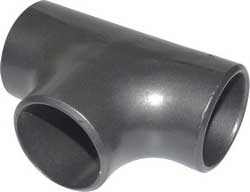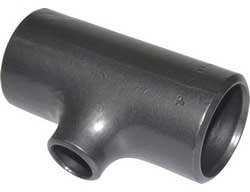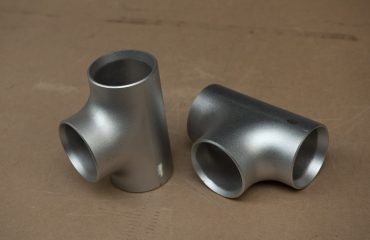
Butt Weld Fitting Tee: Straight Tee and Reducing Tee
Introduction
Butt weld fitting tees are essential components in piping systems, used to connect three pipes at a junction, allowing fluid or gas flow to be split or combined. These fittings are widely employed across industries such as oil and gas, petrochemical, power generation, and water treatment due to their durability, reliability, and ability to handle high-pressure and high-temperature conditions. Butt weld tees are categorized into two main types: straight tees and reducing tees, each serving distinct purposes based on the piping system’s design and flow requirements.


This article provides a comprehensive overview of butt weld fitting tees, including their design, manufacturing standards, material compatibility, advantages, and applications. It also explores the differences between straight tees and reducing tees, our company’s manufacturing capabilities, quality assurance processes, and the benefits of choosing our butt weld tees for your piping projects. With a focus on scientific analysis and practical insights, this article aims to highlight why butt weld tees are critical for efficient and safe piping systems.
Design and Functionality of Butt Weld Tees
What is a Butt Weld Tee?
A butt weld tee is a pipe fitting with three outlets, typically arranged in a T-shape, where two outlets are aligned (the run) and one is perpendicular (the branch). The term “butt weld” refers to the method of joining the tee to the pipes, where the ends of the tee and pipes are beveled and welded together, creating a strong, leak-proof connection. This welding process ensures a smooth internal surface, minimizing turbulence and pressure loss while maintaining structural integrity.
Types of Butt Weld Tees
Butt weld tees are classified based on the diameters of their outlets:
- Straight Tee (Equal Tee):
- All three outlets (two run ends and one branch) have the same nominal diameter.
- Used when the flow needs to be split or combined without changing pipe size, such as in systems requiring equal flow distribution.
- Example: A 6-inch straight tee connects three 6-inch pipes, maintaining consistent flow characteristics.
- Reducing Tee:
- The branch outlet has a smaller diameter than the run outlets, or the run outlets may differ in size.
- Used when the branch pipe requires a reduced flow or when connecting pipes of different diameters.
- Example: A 6-inch x 6-inch x 4-inch reducing tee connects two 6-inch run pipes to a 4-inch branch pipe, accommodating a smaller branch flow.
Standards and Specifications
Butt weld tees are manufactured to meet stringent industry standards to ensure compatibility and performance in piping systems. Key standards include:
- ASME B16.9: Specifies factory-made wrought butt-welding fittings, including dimensions, tolerances, and testing requirements for tees.
- ASTM/ASME A/SA403, A/SA234: Defines material specifications for stainless steel and carbon steel fittings, respectively.
- MSS SP-75: Covers high-strength, butt-welding fittings for high-pressure pipelines, such as those in oil and gas.
- API 5L: Relevant for tees used in pipeline systems, specifying material grades like X42 to X80.
These standards ensure that tees meet dimensional accuracy, pressure ratings, and material properties required for specific applications.
Manufacturing Process of Butt Weld Tees
Our company adheres to ASME B16.9 and other relevant standards in the production of butt weld tees, ensuring high quality and reliability. The manufacturing process involves the following steps:
- Material Selection:
- Tees are made from seamless or welded pipes, selected based on client specifications and application requirements.
- Common materials include:
- Carbon Steel: ASTM A234 WPB, API 5L Gr. B (cost-effective, suitable for general applications).
- Stainless Steel: ASTM A403 WP304/304L, WP316/316L (corrosion-resistant, ideal for chemical and marine environments).
- Alloy Steel: ASTM A234 WP11, WP22, WP91 (high-temperature and high-pressure applications).
- Nickel Alloys: Inconel, Monel, Hastelloy (extreme corrosion resistance).
- Duplex/Super-Duplex Stainless Steel: UNS S31803, S32750 (high strength and corrosion resistance).
- Forming:
- Seamless Tees: Formed using hot or cold extrusion, where a pipe section is shaped into a T-form under high pressure. Hot forming is used for larger sizes or thicker walls, while cold forming ensures precision for smaller sizes.
- Welded Tees: Fabricated by welding two pipe sections together, typically for larger diameters. Weld seams are inspected to ensure integrity.
- Reducing tees are formed with precise control to achieve the required branch diameter, often using specialized dies or hydraulic presses.
- Beveling:
- The ends of the tee are beveled per ASME B16.25 to facilitate butt welding. Standard bevel angles (e.g., 37.5° ± 2.5°) ensure proper weld penetration and strength.
- Heat Treatment:
- Post-forming heat treatment, such as normalizing, stress relieving, or quenching and tempering, is applied to restore mechanical properties and relieve residual stresses. For example:
- Normalizing: Heating to 850°C–900°C and air cooling for carbon steel tees.
- Stress Relieving: Heating to 600°C–650°C for stainless steel tees to reduce welding stresses.
- Post-forming heat treatment, such as normalizing, stress relieving, or quenching and tempering, is applied to restore mechanical properties and relieve residual stresses. For example:
- Surface Treatment:
- Tees are cleaned, shot-blasted, or pickled to remove scale and impurities.
- Optional coatings, such as epoxy, FBE (fusion-bonded epoxy), or galvanizing, are applied for corrosion protection.
- Testing and Inspection:
- Dimensional Inspection: Verifies outer diameter, wall thickness, center-to-end dimensions, and alignment per ASME B16.9 tolerances.
- Visual Examination: Checks for surface defects like cracks, dents, or weld imperfections.
- Mechanical Testing: Includes tensile tests, hardness tests, and impact tests (e.g., Charpy V-notch for low-temperature applications).
- Non-Destructive Testing (NDT):
- Ultrasonic Testing (UT): Detects internal defects.
- Radiographic Testing (RT): Inspects weld seams in welded tees.
- Magnetic Particle Testing (MPT) or Liquid Penetrant Testing (LPT): Identifies surface flaws.
- Hydrostatic Testing: Ensures the tee can withstand design pressure without leaks (optional, based on client requirements).
- Marking and Documentation:
- Each tee is marked with material grade, size, schedule, heat number, and standard (e.g., ASME B16.9).
- A Manufacturer’s Test Certificate (MTC) per EN 10204 3.1 is provided, detailing material properties, test results, and compliance.
Scientific Analysis of Butt Weld Tees
Fluid Dynamics Considerations
The design of butt weld tees impacts fluid flow, particularly at the junction where flow splits or combines. The Darcy-Weisbach equation quantifies frictional losses in piping systems:
Where:
- \(h_f\): Head loss due to friction
- \(f\): Friction factor
- \(L\): Equivalent length of the fitting
- \(D\): Pipe diameter
- \(v\): Fluid velocity
- \(g\): Gravitational acceleration
Straight Tees:
- Cause moderate turbulence at the branch junction, leading to a higher equivalent length (\(L\)) compared to straight pipe.
- Suitable for applications where equal flow distribution is needed, but pressure loss must be minimized.
Reducing Tees:
- Introduce additional turbulence due to the change in diameter, increasing \(h_f\).
- The branch flow is governed by the continuity equation (\(Q = A \cdot v\)), where a smaller branch diameter increases velocity (\(v\)) and potentially pressure loss.
- Careful design, such as smooth transitions and proper branch sizing, mitigates excessive turbulence.
Finite Element Analysis (FEA) is used to simulate flow patterns and stress distribution in tees, optimizing their geometry to reduce pressure drop and ensure structural integrity under operating conditions.
Stress Analysis
Butt weld tees experience complex stress patterns due to internal pressure, thermal expansion, and external loads. Key stress considerations include:
- Hoop Stress: Calculated using the Barlow formula (\(\sigma_h = \frac{P \cdot D}{2t}\)), where \(P\) is pressure, \(D\) is diameter, and \(t\) is wall thickness. The tee’s wall thickness is designed to withstand hoop stress, especially at the crotch (junction of run and branch).
- Shear Stress: Occurs at the branch junction due to flow diversion. Reducing tees may experience higher shear stress due to velocity changes.
- Thermal Stress: In high-temperature applications, thermal expansion differences between the tee and connected pipes are managed through proper material selection and heat treatment.
FEA ensures that stresses remain within allowable limits per ASME B31.3 (process piping) or B31.8 (gas transmission), with safety factors applied to prevent failure.
Advantages of Butt Weld Tees
Butt weld tees offer several benefits over other fitting types (e.g., threaded or socket weld tees), making them ideal for critical applications:
- Strong and Leak-Proof Joints:
- Butt welding creates a continuous, homogeneous connection, eliminating weak points and ensuring leak-free performance under high pressure.
- Smooth Flow Path:
- The welded joint and smooth internal surface minimize turbulence and pressure loss, improving flow efficiency.
- Versatility:
- Available in a wide range of sizes (1/2” to 48” nominal diameter), schedules (SCH 10 to XXS), and materials, suitable for diverse industries.
- Durability:
- Resistant to thermal and mechanical stresses, making them ideal for high-temperature, high-pressure, and corrosive environments.
- Reduced Maintenance:
- Fewer welds and robust construction reduce the need for frequent inspections and repairs compared to fabricated tees.
- Cost-Effective for Large Systems:
- While initial fabrication costs may be higher, the long-term reliability and reduced maintenance make butt weld tees economical for large-scale projects.
- Compliance with Standards:
- Manufactured to ASME B16.9 and other standards, ensuring compatibility with global piping systems.
Straight Tee vs. Reducing Tee: Key Differences
| Feature | Straight Tee | Reducing Tee |
|---|---|---|
| Outlet Diameters | All three outlets have the same diameter. | Branch outlet is smaller than run outlets, or run outlets differ. |
| Application | Equal flow distribution or combination. | Connecting pipes of different sizes or reducing branch flow. |
| Flow Characteristics | Minimal turbulence, lower pressure loss. | Higher turbulence due to diameter change, increased pressure loss. |
| Design Complexity | Simpler, symmetrical design. | More complex, requires precise branch sizing. |
| Common Use Cases | Main pipeline junctions, balanced systems. | Branch lines, flow restriction, compact layouts. |
| Manufacturing | Easier to form due to uniform diameter. | Requires specialized forming for branch reduction. |
Example:
- A straight tee (8” x 8” x 8”) is used in a gas transmission pipeline to split flow equally between two 8-inch lines.
- A reducing tee (8” x 8” x 6”) connects an 8-inch main line to a 6-inch branch for a secondary process line in a refinery.
Our Company’s Butt Weld Tee Manufacturing Capabilities
As a leading manufacturer of butt weld fittings, our company specializes in producing high-quality straight and reducing tees that meet ASME B16.9 and client-specific requirements. Our capabilities include:
- Advanced Manufacturing Facilities:
- Equipped with hot and cold extrusion presses for seamless tees and automated welding systems for welded tees.
- Capable of producing tees from 1/2” to 48” in diameter and wall thicknesses from SCH 5 to XXS.
- Material Expertise:
- Extensive inventory of carbon steel, stainless steel, alloy steel, and exotic alloys to meet diverse application needs.
- In-house metallurgical testing ensures material compliance with ASTM, ASME, and API standards.
- Customization:
- Producing tees with non-standard dimensions, angles, or special coatings (e.g., 3LPE for buried pipelines).
- Offering compound tees for complex piping layouts, such as multi-branch systems.
- Cutting-Edge Equipment:
- CNC-controlled beveling machines for precise weld end preparation.
- Automated heat treatment furnaces for consistent normalizing, stress relieving, or quenching and tempering.
- Laser-based inspection systems for dimensional accuracy and NDT equipment for defect detection.
- Integrated Inspection Services:
- Dimensional Checks: Using calipers, laser scanners, and CMM (Coordinate Measuring Machines) to verify center-to-end dimensions and tolerances.
- NDT: UT, RT, MPT, and LPT performed by ASNT Level II/III-certified inspectors.
- Mechanical Testing: Tensile, hardness, and impact tests conducted in our ISO 17025-accredited laboratory.
- Traceability: Full documentation, including MTCs and heat number tracking, ensures compliance and quality assurance.
- Coating and Finishing:
- Applying corrosion-resistant coatings like FBE, epoxy, or galvanizing.
- Surface treatments such as pickling, passivation, or electro-polishing for stainless steel tees.
Applications of Butt Weld Tees
Butt weld tees are used in a variety of industries due to their versatility and reliability:
- Oil and Gas:
- Straight tees for main pipeline junctions in crude oil or natural gas transmission.
- Reducing tees for branch lines to processing units or storage facilities.
- Petrochemical:
- Reducing tees in process piping for connecting reactors, heat exchangers, or distillation columns.
- Stainless steel tees for handling corrosive fluids like acids or solvents.
- Power Generation:
- Alloy steel tees in high-pressure steam or feedwater systems in thermal or nuclear power plants.
- Straight tees for cooling water distribution.
- Water Treatment:
- Carbon steel tees with epoxy coatings for water supply and wastewater systems.
- Reducing tees for branching to smaller distribution lines.
- Shipbuilding and Offshore:
- Duplex stainless steel or copper-nickel tees for seawater piping in ships or offshore platforms.
- Reducing tees for hydraulic or cooling systems.
- Infrastructure:
- Straight tees in district heating or HVAC systems for equal flow distribution.
- Galvanized tees for buried water or gas pipelines.
Case Studies: Real-World Applications
1. Oil and Gas Pipeline Project:
Challenge: A client required 12-inch straight tees (API 5L X60) for a 200-km natural gas pipeline to split flow into two parallel lines.
Solution: We manufactured seamless straight tees with normalizing heat treatment to ensure toughness. RT and UT confirmed weld-free integrity, and FBE coating was applied for corrosion protection.
Outcome: The tees reduced pressure loss by 10% compared to fabricated junctions, improving pipeline efficiency and reducing compressor energy costs.
2. Petrochemical Plant Upgrade:
Challenge: A refinery needed 10” x 10” x 8” reducing tees in stainless steel (ASTM A403 WP316L) for a corrosive process line with space constraints.
Solution: We produced reducing tees with precise branch sizing using cold extrusion, followed by passivation to enhance corrosion resistance. FEA optimized the tee design for high-pressure operation.
Outcome: The tees were installed in a compact layout, reducing welding by 15% and ensuring zero leaks after two years of operation.
Conclusion
Butt weld fitting tees, including straight and reducing tees, are indispensable components in modern piping systems, offering strength, reliability, and versatility. Straight tees ensure equal flow distribution, while reducing tees accommodate varying pipe sizes, making them suitable for diverse applications in oil and gas, petrochemical, power generation, and infrastructure projects. Our company’s expertise in manufacturing ASME B16.9-compliant tees, combined with advanced equipment, rigorous inspection services, and customized solutions, positions us as a trusted partner for your piping needs.
By leveraging scientific principles, such as fluid dynamics and stress analysis, and employing state-of-the-art manufacturing processes, we deliver butt weld tees that meet the highest standards of quality and performance. Whether you require seamless straight tees for high-pressure pipelines or reducing tees for complex process systems, our commitment to innovation, sustainability, and customer satisfaction ensures exceptional results. Contact us today to discuss how our butt weld tees can enhance your next project.



You must be logged in to post a comment.